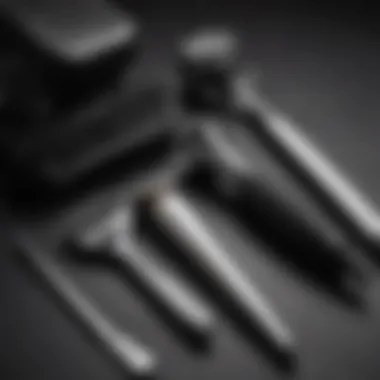Ultimate Guide to Hair Removal for Men’s Intimate Areas


Haha
Understanding the Need for Hair Removal
Hair removal in male private areas is a discussion that extends beyond mere aesthetics. It encompasses aspects of personal hygiene, cultural norms, and ultimately one's own comfort. Understanding the motivations behind this grooming practice can lead to better decisions tailored to individual needs.
Personal Hygiene and Grooming
Maintaining personal hygiene is an essential factor that drives many men to consider hair removal in their intimate areas. Hair can trap moisture, sweat, and odor, contributing to an environment that is not conducive to cleanliness. Regular grooming can aid in reducing the potential for uncomfortable feelings throughout the day.
Moreover, better grooming can also lead to improved skin health. Removing hair can help decrease friction and the risk of ingrown hairs and irritation, particularly during physical activity or warm weather. This practice is not just about appearance, but also about maintaining skin integrity and preventing discomfort.
Cultural and Societal Influences
Cultural expectations have had a substantial impact on grooming practices globally. In many societies, a hairless or neatly groomed pubic area aligns with modern standards of masculinity and attractiveness. Men are increasingly influenced by visual media and peer culture, which often idealize specific grooming styles.
There is a growing community online, especially on platforms like Reddit and Facebook, where men share their experiences and tips about hair removal. Joining these discussions can offer insights into the different practices accepted in society today, thus both normalizing and correlating successful grooming techniques with broader acceptable male imagery in fashion and lifestyle.
Comfort and Aesthetics
From a comfort perspective, hair removal can significantly enhance the feel of underwear and swimwear. Many men have remarked that they prefer the sensation of smooth skin during physical activities or casual encounters. In addition, some also feel more confident and attractive when they engage in grooming.
From an aesthetic viewpoint, the look and appeal of a groomed area can bolster personal satisfaction and self-image. Whether it’s for a special occasion or just daily routine, a well-maintained appearance contributes to the feeling of readiness to face the world.
Professional methods or DIY options exist for every comfort level, and making informed choices is pivotal to achieving desired results without unnecessary stress.
In summary, understanding the need for hair removal aids men in realizing its multifaceted value. The decision can be personal or influenced by cultural norms, with comfort playing a central role in a well-rounded men’s grooming routine.
Preparation for Hair Removal
Preparation is critical to achieving safe and satisfactory hair removal from male private areas. Neglecting preparations can lead to complications, discomfort, and unexpected outcomes. Understanding one's unique needs and the appropriate actions before engaging in any hair removal method is essential. The emphasis here is on methodical assessment and thoughtful choices that ensure skin safety while promoting comfort.
Assessing Skin Type
Every individual's skin reacts differently to various grooming techniques. Hence, assessing skin type is a foundational step. Skin can be categorized as oily, dry, sensitive, or a combination thereof.
- Oily Skin: This tends to develop breakouts easily. Choosing a hair removal method that minimizes pore blockage and irritation is key.
- Dry Skin: This skin type can become irritated if enough moisture isn't provided. It may be beneficial to utilize moisturizing creams prior to hair removal.
- Sensitive Skin: Caution is needed here, as certain products can cause a reaction. Test any creams or razors on a small skin section first.
- Combination Skin: This can complicate the process. Different hair removal solutions may be more suitable for different areas.
Identifying one’s own skin type sets the stage for informed product selection, reducing potential irritation.
Choosing the Right Tools
Utilizing the correct tools for hair removal does not simply enhance effectiveness; it also reduces the risk of injury or skin damage. The choices are varied, and each tool serves a distinct purpose:


- Razors: Selecting a high-quality razor that offers multiple blades can provide a closer, cleaner shave while minimizing the chance of cuts. Additionally, razors designed specifically for sensitive areas can ensure a comfortable experience.
- Waxing Kits: These kits should also be appropriate for sensitive skin if specific waxing methods are chosen. Look for ones with skin-soothing ingredients.
- Depilatory Creams: These often come with skins specifics. Ensuring you're selecting formulas meant for genital areas is crucial.
- Laser or Electrolysis Tools: For longer-term hair removal, affordable home devices, or professional services may be options to consider, keeping in mind the investment related to their effectiveness.
Having the proper tools cannot be overemphasized. It contextualizes the process and aligns expectations towards successful outcomes.
Cleaning and Exfoliating the Area
Before diving into hair removal, cleansing the targeted area cannot be ignored. Cleansing and exfoliating will eliminate dirt, oil, and dead skin. This contributes significantly to minimizing potential infections post-removal.
- Clean: Use a mild cleanser that does not irritate the skin. Avoid harsh soaps or those with fragrances.
- Exfoliate: A gentle exfoliating scrub can help by removing dead skin cells. This facilitates a closer shave or waxing experience by allowing tools to glide smoothly. It's a good idea to exfoliate the area one day before the hair removal session.
- Hydration: Follow cleaning and exfoliating with a suitable moisturizer. Hydrating the area keeps the skin supple and reduces the chance of irritation post-procedure.
Regularly disregarding these preparations sets the user up for complications such as ingrown hairs and infections. The risks can be mitigated by adhering to a regimented care routine. Following these essential preparatory steps can drive better satisfaction through effective hair removal and improved skin condition.
Proper preparations lead to more successful hair removal experiences, minimizing skin irritation and enhancement overall comfort.
Common Hair Removal Methods
The methods of hair removal vary significantly in technique and effectiveness. Understanding these methods helps men make informed choices tailored to their personal preferences and skin types. Proper knowledge allows one to select the best method that suits not only their style but also their skin's tolerance. Each hair removal technique has unique benefits and potential drawbacks. Here’s a detailed overview of the most common hair removal methods.
Shaving Techniques
Choosing the Right Razor
Selecting the appropriate razor is crucial for a successful shaving experience. A good razor can minimize irritation and enhance closeness. For sensitive skin, a razor with multiple blades is often recommended. These razors provide a smoother glide over the skin. An electric razor is a popular option as well, offering convenience and reduced risk of cuts. Choosing a razor should involve considering skin type, hair thickness, and personal technique. Lightweight and hypoallergenic designs also attract those prone to allergies.
Shaving Cream vs.
Gel
The choice between shaving cream and gel can affect the quality of the shave. Shaving creams are known for their moisturizing properties. They typically create a rich lather that softens hair better. Gels tend to be clear, allowing for a more precise shave. They are often lighter and can help with visibility. The texture ultimately comes down to personal preference. However, men should consider their skin type when selecting the product. For dry skin, cream might be the best option compared to gel which can sometimes contain alcohol that tans skin.
Proper Shaving Technique
Using proper shaving technique ensures minimal irritation. Always start with a clean, moist area. Shaving in the direction of hair growth reduces the chances of ingrown hairs. Light, short strokes are recommended to avoid tugging on the skin. It's important to rinse the blade frequently to keep it free of hair and product build-up. Once finished, pat the area dry gently. Follow up with a soothing balm to protect sensitive skin.
Waxing Considerations
Types of Wax
Different types of environmental waxes areavailable for hair removal. Hard wax systems adhere only to hair and not to the skin, which can reduce pain. Soft wax requires strips and can grab more hairs at once. Natural waxes often include unwanted additives such as fragrances or dyes, which can cause reactions on sensitive skin. Solid wax offering, like those from Kaila, globally sphere up male grooming channels; hence understanding them allows users to gamble that valuable pain away .
Pros and Cons of Waxing
Waxing provides a longer-term solution compared to shaving. Results last a number of weeks, reducing the frequency of hair removal. However, the process can be painful and may require professional assistance at times. Skin irritation is also a risk, particularly for those with sensitive skin. Weighing the short-term discomfort against the length of results is essential in decided on this treatment method.


Post-Wax Care
Post-wax care is crucial in avoiding complications. Soothe the skin with aloe vera or a balm post-wax. Avoid tight clothing and activities that may cause sweating right after waxing to ensure fewer irritations and a faster recovery. Healing also allows skin to recover and reduces chances of irritation.
Depilatory Creams
How Depilatory Creams Work
Depilatory creams dissolve hair using chemicals. They penetrate the hair follicle without messing with the skin layers. The effects can last longer than shaving, but the solution may not suit all skin types. Reading labels and potentially performing a patch test can restrict unwanted reactions, allowing better discussion on this method for hair removal which keeps those busy Amazon guys actively stitched without pain while aiding for spells
Application Tips
While using depilatory creams, follow product instructions carefully. Applying product equally prevents missed spots or missed targets. Establish which time frame will allow optimal effect before you remove and wash off necessarily. Always test on a small skin area to gauge the results and adverse reactions. Products recommended from East India or those labeled as remedies tend to lead males discarded boasting from miable dried customs to accords.
Safety Precautions
When it comes to hair removal from male private areas, safety is a critical factor. The skin in these regions is particularly sensitive and requires careful attention. Ignoring safety precautions may lead to complications such as irritations, infections, or unwanted allergic reactions. Therefore, it is essential to adopt a methodical approach to hair removal, ensuring that proper safety measures are followed throughout the process.
Avoiding Skin Irritation
Skin irritation can occur due to friction, harsh products, or incorrect techniques. To minimize the risk, consider the following methods:
- Pre-Removal Preparation: Start with a thorough clean. Warm water helps open pores, making hair removal smoother and more comfortable.
- Use Appropriate Products: Select products designed for sensitive skin. Shaving creams or post-wax lotions formulated specially for intimate areas can significantly reduce irritation.
- Avoid Over-Trimming: If you opt for trimming instead of shaving or waxing, avoid going too close to the skin. Trimming too closely can cause skin irritation and itching.
- Hydrate Skin After Removal: Moisturizing may soothe and protect the skin. Lightweight, alcohol-free lotions are ideal as they provide hydration without obstructing pores.
By following these key recommendations, you preserve skin integrity and enhance overall comfort.
Recognizing Allergic Reactions
Allergic reactions can manifest in various forms, leading to discomfort and complications post-embellishment. Symptoms may range from mild to severe. It is pivotal to be vigilant and recognize signs of an allergic response. Here are important pointers:
- Monitor Redness or Swelling: Post-removal, monitor for excessive redness, swelling or rashes. These indicate potential allergic reactions.
- Look for Itching or Burning Sensations: Unusual discomfort following hair removal could suggest your skin is reacting adversely to a product or method used.
- Conduct Patch Tests: Always conduct a patch test if trying new products, such as depilatory creams or waxes, before wider application.
By being mindful of these symptoms and implementing these strategies, you can recognize and address allergic reactions quickly, ensuring safety while maintaining grooming preferences.
Always remember that maintaining skin health is equally as important as achieving your desired appearance. Protecting your skin should be the priority in any grooming routine.
Aftercare for Hair Removal
Aftercare is a crucial aspect often overlooked in the hair removal process. While techniques for removing hair are significant, the steps taken post-removal can dictate the success of the procedure. Proper aftercare ensures not only comfort but also the prevention of complications. Ignoring aftercare may lead to skin irritations or infections, which can significantly impact one's grooming routine.
The well-being of the skin in sensitive areas requires attention and diligence after hair removal. This section discusses various elements to consider.
General Skin Care


Moisturizing Techniques
Moisturizing is vital after hair removal as it helps hydrate the skin and offers relief from any potential irritation. Using a suitable moisturizer can soothe any discomfort and promote the healing process of the skin. Selecting lightweight, non-comedogenic moisturizers can be beneficial. Such products prevent clogging of pores while providing necessary hydration.
Key features of moisturizing include their ability to restore skin's natural balance and alleviate dryness. Many men appreciate moisturizers with aloe vera or chamomile for their calming properties.
Advantages of moisturizing also encompass the prevention of flaky or itchy skin. However, it's crucial to avoid products with strong fragrances or alcohol, which may irritate the delicate skin further.
Avoiding Tight Clothing
Wearing tight clothing after hair removal can inhibit proper recovery. Loose-fitting attire allows the skin to breathe, reducing the potential for irritation and friction. The freedom and comfort from unrestricted movements assist in minimizing discomfort, providing space for skin healing.
One key characteristic of this practice is to prioritize ventilation, especially in sensitive areas. Loose clothing can prevent chafing and maintains a suitable environment for skin regeneration.
A notable feature of this approach is achieving balance between style and comfort. Tight-fitting styles may look great but can quickly turn sour if they compromise skin health. Thus, one should opt for breathable fabrics to enhance overall comfort during post-removal phases.
Signs of Complications
Identifying Infections
Understanding how to identify potential infections post hair removal is essential for effective aftercare. Symptoms may include excessive redness, swelling, or purulent discharge. Prompt detection of these signs can prevent the condition from worsening.
The ability to recognize unusual changes in the skin empowers individuals to engage in timely care. Ignoring indications of infection can lead to severe outcomes, impacting one's overall hygiene and grooming regimen.
An innovative feature of this approach highlights the importance of aesthetics in conjunction with health. Maintaining beauty is not just about appearances but is linked to how the skin reacts to procedures such as hair removal.
When to See a Doctor
Knowing when to see a medical professional is critical after hair removal. If the skin fails to improve within several days or if symptoms worsen, seeking advice is essential. Primary indicators for a consultation may include increasing pain, or the presence of pus or fever alongside skin symptoms.
Prompt actions will not only mitigate further risks but exhibit responsible care and meticulous attention to personal health. A unique advantage of recognizing these signs early is minimizing longer-term issues that could emerge.
This step is significant, ensuring that the body receives adequate medical attention without delay.
Remember, post-hair removal care is just as important as the act itself. Prioritizing it can mean the difference between discomfort and well-being.
Epilogue
In this discussion on hair removal methods for male private areas, it is essential to consider not only the various techniques available but also the broader implications these methods have for personal grooming and comfort. Choosing how to remove hair from sensitive areas is a personal choice that reflects individual values related to hygiene, aesthetics, and societal norms.
Reflecting on Personal Choices
Personal grooming decisions are deeply individual. What works for one person might not suit another. Understanding your preferences is critical. Reflecting on your choices involves evaluating your skin type, hair thickness, and sensitivity to products. This self-awareness leads to a more satisfying grooming experience. It also minimizes the risk of complications, such as irritation or allergic reactions. Moreover, participating in society's trends should not overpower personal comfort and desires. As such, men should feel empowered to pursue techniques that best align with their aesthetic hopeful without succumbing to peer pressure or misleading information.
Emphasizing Safety and Comfort
Prioritizing safety while shaving or waxing can make a significant difference in your grooming results. Knowing about potential risks ensures that men take necessary precautions to protect their skin. Using appropriate tools, following the right processes, and applying aftercare all contribute to a plasticuring and safe removal experience. It is important to create a commitment to discomfort-free and secure grooming practices. Awareness of healing time and signs of complications can be valuable here. When undertaking any hair removal technique, echoing a focus on health and wellbeing should be paramount in all grooming interfaces.
Ultimately, an informed approach to grooming promotes confidence and enhances personal appearance. Ensuring comfort—coupled with efficiency—serves as a solid foundation for a successful grooming routine. As dignity in grooming becomes evident, habits fostered through awareness will become integral part of a male grooming identity.















